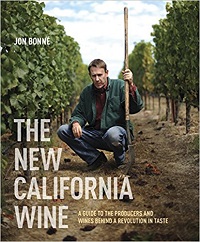 If you have been drinking California wines over the last several decades you might have noticed that they are constantly changing. These changes are the focus of Jon Bonné’s book, The New California Wine: A Guide to the Producers and Wines behind a Revolution in Taste. With a palate trained by Old World wines and experience being the wine editor of the San Francisco Chronicle, Bonné surveys the wine making industry of California, explains the changes, and provides an intimate look at the land and winemakers responsible for those changes.
If you have been drinking California wines over the last several decades you might have noticed that they are constantly changing. These changes are the focus of Jon Bonné’s book, The New California Wine: A Guide to the Producers and Wines behind a Revolution in Taste. With a palate trained by Old World wines and experience being the wine editor of the San Francisco Chronicle, Bonné surveys the wine making industry of California, explains the changes, and provides an intimate look at the land and winemakers responsible for those changes.
The book is divided into three sections: first, the author identifies the changes taking place and the wine makers responsible for the changes; second, a description of the regions that are significant in defining the new California wines, and third, a guide to the new California wines organized by grape variety with details on producers and their wines. In the first section we learn about the impact of prohibition, the Judgment of Paris, and the significance of phylloxera in the development of the California wine industry. Bonné explains the factors that led to the belief that the type of soil didn’t matter and how the manipulation of wine chemistry arose. He points out further that new California wines emerged as winemakers realized that the land (terroir) was important and that winemakers who grew their own grapes were in the best position to produce fine wines.
The second section of the book develops the concept of terroir and applies it to California. It takes a look at areas from Sonoma and Paso Robles to Ventucopa and Lodi, with descriptions of the wineries as well as of the growers and winemakers that are producing new California wines. You hear the stories of the people who are on the cutting edge of the new trend in California wines and how they came to settle where they are and produce wine the way they do.
In the final section, Bonné zeros in on specific new California wines by grape varietals. He gives the history of the grape in California, trends in wine making, and then puts the spotlight on producers giving a brief description of each and listing a selection of their wines with a suggestion of their price range. Well known producers like Drew Family, Ridge Vineyards, and Turley Wine Cellars are well represented along with many other less well known ones. Most of the wines listed are in the $20-$80 range. Throughout the section insets called “The Three-Bottle Tour” suggest wines that typify the new trend. Other insets provide information on topics such as the evolution of cult wines, concerns of the wine industry about climate change, and innovations in the cellar.
The New California Wine is a very readable introduction to the new trend in California wine making. Working from the premise that terroir is a better way of producing wine than manipulating its chemistry, the author explores both the land and the winemakers of California that are leading the way in the development of the new California wines. The narrative is easy to understand and enhanced with many stories and insets that provide additional information on such topics as keg wines, the birth of the Lompoc Wine Ghetto, and the rise and fall of San Francisco’s Crushpad. The photographs are disappointing, however, as most have no captions and add little to the text so don’t buy the book for the pictures.
And, just a personal note. Since we live in California about four months of the year, the book has been a fantastic introduction to the producers of these new California wines. Using the book as a guide we have begun to purchase wines from producers listed in the book and have found their wines to be truly revolutionary and memorable. You can find our reviews of these wines by searching the keyword “New California Wine” in the TastedOnline.com Keyword Index.
To buy The New California Wine from Amazon.com Click Here.